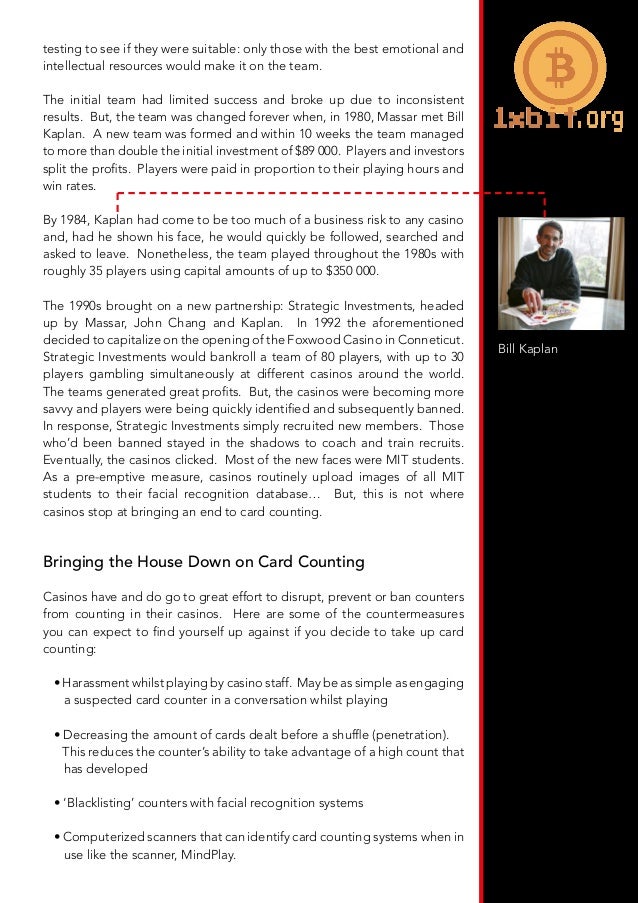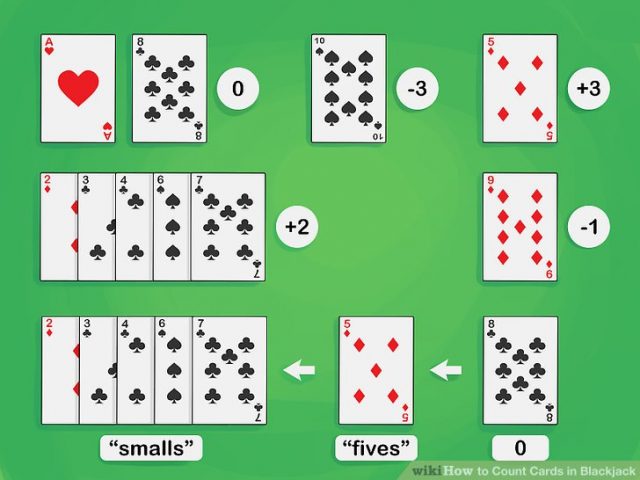Card Counting Systems Compared
Card Counting Systems Compared

Romes, this is the same Tarzan from Norm's site, who, I can't even call him a proponent of complex counts and systems, because what he employs is so unique it can't really be compared to anything else. But in general terms, when he weighs in on one of the count debate threads, he sides with the 'proponents of complexity'.
- The MIT Blackjack Team was a group of students and ex-students from the Massachusetts Institute of Technology, Harvard University, and other leading colleges who used card counting techniques and more sophisticated strategies to beat casinos at blackjack worldwide. The team and its successors operated successfully from 1979 through the beginning of the 21st century.
- Other card counting techniques. Hi-Lo is the standard card counting technique. Low cards are assigned +1, high cards -1 and in the middle are 0.
- It works using the following card count: Cards of value between 2 and 7 are counted as +1; 10 and ace cards are counted as -1; Other cards require no count. The simplicity of the REKO system makes it ideal for multi-deck games and the more decks are used in a game, the more powerful the system becomes. It is known as an unbalanced system.
- Design and selection of systems. The primary goal of a card counting system is to assign point values to each card that roughly correlate to the card's 'effect of removal' or EOR (that is, the effect a single card has on the house advantage once removed from play), thus enabling the player to gauge the house advantage based on the composition of cards still to be dealt.
Card Counting Systems Compared
According to Norm Wattenberger, the expert on card counting
who runs QFIT, the Revere Point Count system is the best of
Lawrence Revere’s multiple advantage play systems for getting an
edge over the casino at blackjack. In most ways, the Revere
Point Count works like every other card counting system. But the
details are what make card counting systems interesting.
This page provides an overview of Lawrence Revere and his
importance in the field of blackjack advantage play, how card
counting works in general, and how to use the Revere Point Count
yourself to get an edge over the casino.
Who Was Lawrence Revere?
Griffin K. Owens was a pivotal figure in the field of
blackjack advantage play, and by many accounts, was one of the
real characters in the game. But most people know him better
under his pen name, Lawrence Revere. But those aren’t the only 2
names he went by. He was also known for playing under aliases
like Paul Mann and Leonard “Speck” Parsons.
His degree in math from the University of Nebraska no doubt
helped him in his career as a professional blackjack player and
author. Counting cards doesn’t require advanced math, but
developing your own systems and understanding them at the level
that Revere did is another feat entirely from just counting and
getting an edge over the casino.
The Revere Point Count is just one of 4 different systems he
developed with Julian Braun, another giant in the field of
blackjack advantage play. The other systems are also detailed on
this site, including:
- Revere 5 Count
- The Revere Plus Minus Count
- The Ten Count
Like many of the authorities in the niche, Revere published
versions of his systems in books. But he also had proprietary
versions that were available for sale. The Revere Point Count is
a system that’s featured in his book Playing Blackjack as a
Business, but as published, it’s only truly effective for single
deck games. To learn how to use the system in multiple deck
games, you have to buy the proprietary version of the system.
His other card counting systems are more or less outdated, as
the goals they achieve can be achieved with simpler and
easier-to-use systems that have been developed later.
If you’ve read Lance Humble’s The World’s Greatest Blackjack
Book, you’ll know that Revere was quite a character. If Humble
is to be believed, Revere was a little on the shady side. Since
he worked both sides of the table in blackjack, advising both
players and casinos, that claim seems to have some truth to it.
It’s hard to imagine that this isn’t a clear conflict of
interest situation.
Even though Revere died on April 23, 1977 of cancer, his
website is still live, and you can still buy copies of his book,
Playing Blackjack as a Business.
How Card Counting Works in General
If you’ve read either of the books cited in the last section,
you probably already have a reasonably good idea of how card
counting in general works. But if you’re completely new to the
subject, here’s the why and the how behind counting cards in
blackjack:
Blackjack is unique among casino games in the sense that the
game itself has a memory. Imagine if you were playing roulette,
and every time a particular winning result were hit, it
disappeared from the roulette wheel. That would change the odds
for every bet available, right?
Suppose, for example, that red 32 just got hit, and it was
taken off the wheel. A bet on red 32 at this point would now
have a 0% chance of winning. All of the other single number bets
would have a 1/37 chance in winning instead of 1/38.
Blackjack works the same way. Once a card is dealt out of the
deck, the chances of getting that card are reduced to 0. The
chances of getting any of the other cards go up.

One hand in blackjack pays off at 3 to 2 instead of even
money. That hand is called a “natural” or a “blackjack”, and it
consists of a 10 and an ace. If there are more aces and 10s in
the deck than the lower value cards, your chances of getting a
blackjack improve. If the number of aces and 10s are
proportionally fewer, your chances of getting a blackjack
decrease.
Don’t believe me?
Think about it this way:
ExampleIf you’re playing in a single deck blackjack game, and all
the aces have been dealt, your odds of getting a blackjack have
been reduced to 0%. It’s impossible to get a natural if you
can’t possibly be dealt an ace.
If you bet more when you have a higher chance of getting a
blackjack, and bet less when you have a lower chance, you change
the house edge of the game. Ordinarily, a player using perfect
basic strategy faces an edge of about 0.5% against the casino.
But if he’s counting cards, the counter has an edge over the
casino of 1% or maybe even 2%.
How to Use the Revere Point Specifically to Get an Edge Over
the Casino
It’s not necessary for a player to memorize an entire deck of
cards or even part of it to get this edge, either. Card counters
use a system to estimate the proportion of high cards to low
cards. They do this by assigning values to certain cards and
keeping a mental running count.
Low cards are counted as positive, while high cards are
counted as negative. The count moves up and down based on which
cards have been dealt. When the deck is reshuffled, the count
starts over.
In the Revere Point Count, the cards are given the following
values:
- Aces and 10s are -2
- 3s, 4s, 5s, and 6s are +2
- 2s and 7s are +1
- 8s and 9s are 0.
Perceptive readers will notice that there are more cards with
+ values than – values. This is an example of an unbalanced card
counting system. In most simpler systems, the total when
counting through a deck winds up at 0 because there are as many
+ values as -.
This is also an example of a 2-level system. In simpler
systems, the count goes up and down by a single amount, usually
1. But in the Revere Point Count, some cards count as 1 and some
as 2.
More complex systems are harder to use but provide better
results. Since these are just methods for estimating your
advantage at any given point, they’re never 100% accurate.
Sites like QFIT estimate how accurate various card counting
systems are for certain purposes. The numbers used to describe
their accuracy are usually a number between 0 and 1. Probably
the most important of these metrics is the betting correlation.
That’s a measure of how well the system predicts when you should
raise and lower your bets.
That’s about as accurate as you could ask for.
Another metric is playing efficiency. This measures how well
the system advises you on when to change your playing
decisions—card counters deviate from basic strategy in some
instances. The playing efficiency for the Revere Point Count is
0.55. That sounds low when compared to 0.99, but the playing
efficiency is always significantly lower than the betting
correlation. In fact, some card counters don’t even bother
deviating from basic strategy—they just focus on getting their
edge from raising and lowering their bets.
Insurance correlation is another metric. This system scores
0.78 on that metric, which is pretty good. Taking insurance when
there are more 10s and aces in the deck makes sense when you
think about it. After all, insurance is just a bet that the
dealer will have a natural. If you have higher odds of getting a
blackjack, so does the dealer. After all, you’re both being
dealt cards from the same deck.
The Pros and Cons of the Revere Point Count Compared to
Other Systems
The Revere Point Count is a good system for more advanced
players. It’s a little more complicated than a single level
balanced system, but not extraordinarily so. And it does offer
distinct mathematical advantages over those systems.
On the other hand, it doesn’t really work as well in a
multi-deck game. You can adapt it for use in a multiple deck
environment, but we’re of the opinion that you should use the
right tool for the job. Other counting systems do a better job
of getting you an edge in those other games.
So if you’re going to stick with single deck games, this
might be a good count to use.
Summary
Lawrence Revere is one of the more interesting characters in
blackjack literature. The Revere Point Count is a reasonably
easy but more advanced card counting system than many others.
You can use this system to get an edge over the casino without
too much trouble or practice.
The Omega 2 Count was introduced by Bryce Carlson in his book Blackjack for Blood. It's a balanced card counting system with multi-level values.
The Omega 2 Count is an intermediate-level card counting system for blackjack. Learn this system only after mastering a simple card counting system. When compared to popular counting systems such as Hi-Lo Count and Knockout Count, the Omega 2 system offers a bit more challenge but also greater profitability.
| When Dealt | Count |
|---|---|
| 4, 5, 6 | +2 |
| 2, 3, 7 | +1 |
| 8, A | 0 |
| 9 | -1 |
| T, J, Q, K | -2 |
Card Counting Systems Compared Two
In order to master the system, one must know how to convert from running count into true count. This adds a little bit to the difficulty level of Omega 2 system - but not to worry, it's just simple mathematics. (Just divide the running count with the amount of decks in use.)
Card Counting Systems Compared One
Hi Opt 2 Count is another system of similar difficulty.
Card Counting Systems Compared
